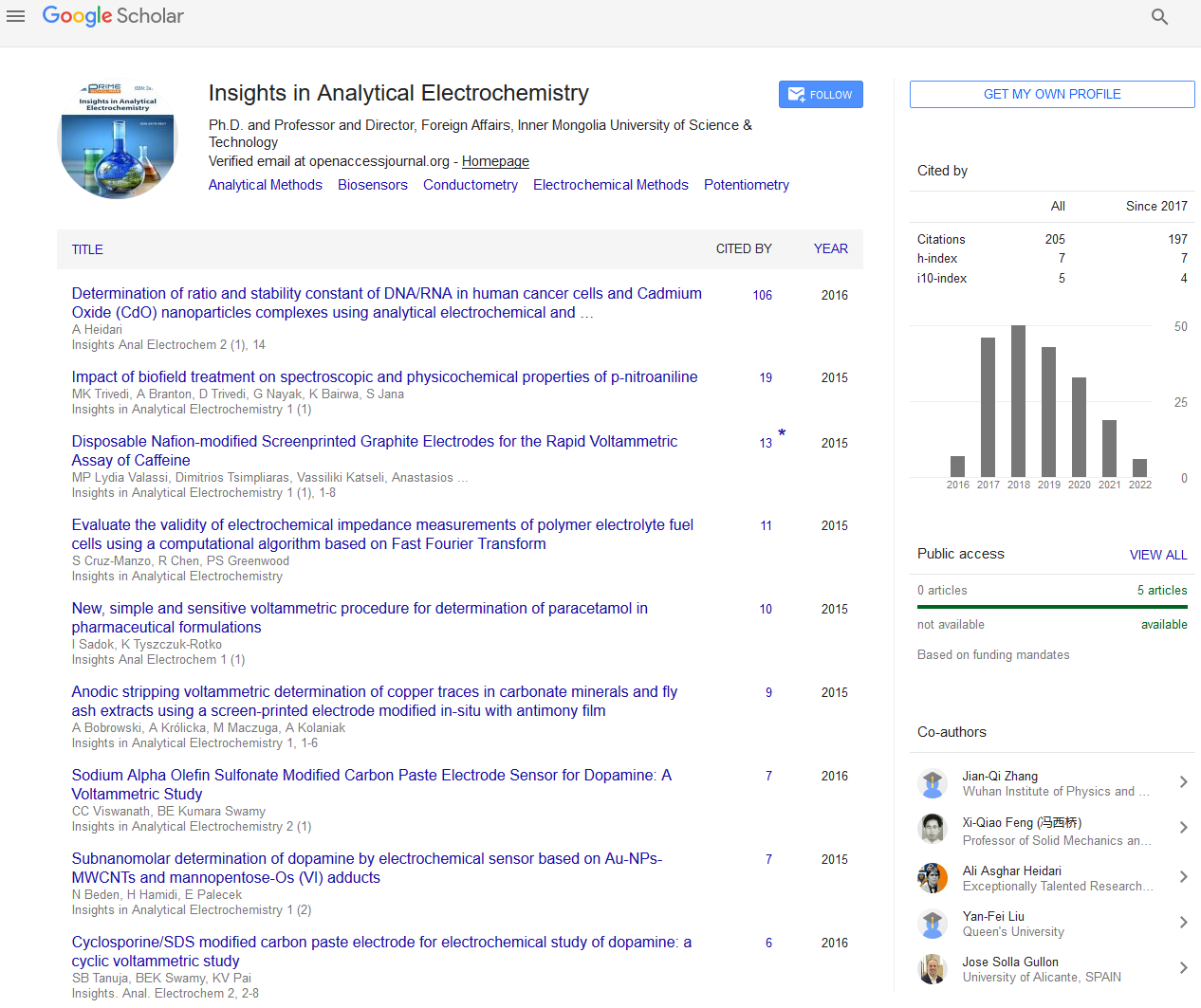Opinion - (2023) Volume 9, Issue 4
Unveiling the Wonders of Conductometry: A Journey into Electroanalytical Excellence
Nicolas Floquet*
Department of Chemical Engineering, Hacettepe University, Turkey
*Correspondence:
Nicolas Floquet,
Department of Chemical Engineering, Hacettepe University,
Turkey,
Email:
Received: 29-Nov-2023, Manuscript No. ipaei-24-18856;
Editor assigned: 01-Dec-2023, Pre QC No. ipaei-24-18856 (PQ);
Reviewed: 15-Dec-2023
Revised: 20-Dec-2023, Manuscript No. ipaei-24-18856 (R);
Published:
27-Dec-2023, DOI: 10.21767/2470-9867-9.4.36
Introduction
In the realm of analytical chemistry, one method stands
out for its precision, versatility, and broad applicationconductometry.
This electroanalytical technique measures the
electrical conductivity of a solution, offering valuable insights
into the nature of substances dissolved within. With a rich
history dating back to the early 20th century, conductometry
has evolved into a sophisticated tool essential for a myriad of
scientific disciplines. At its core, conductometry relies on the
principle that the ability of a solution to conduct electricity
is directly proportional to the concentration of ions present.
Ionic conductivity, a fundamental property, plays a pivotal role
in the success of this technique. When an electric current is
applied to a solution, ions move towards oppositely charged
electrodes, facilitating the flow of electricity. The conductivity
is then measured and correlated with the concentration of
ions, providing a quantitative assessment of the solution’s
composition.
Description
Conductometry finds its most widespread applications in
analytical chemistry, where it serves as a cornerstone in
determining the concentration of ions in a solution. Titration,
a classic analytical technique, often utilizes conductometry
for the endpoint determination. In titrimetric experiments,
the sudden change in conductivity signifies the completion of
a chemical reaction, aiding in the accurate calculation of the
unknown concentration. Furthermore, conductometry plays a
crucial role in studying reaction kinetics. By monitoring changes
in conductivity over time, researchers gain valuable insights
into reaction mechanisms, rate constants, and the overall
kinetics of chemical processes. This makes conductometry
an indispensable tool for understanding the dynamics of
various chemical reactions. In recent times, the importance
of conductometry has extended beyond the laboratory to
environmental monitoring. The technique is employed to
assess the quality of water by measuring the conductivity of
aqueous solutions. This is particularly significant in identifying
the presence of contaminants, such as dissolved salts or
heavy metals, which can have detrimental effects on aquatic
ecosystems and human health. Conductometry also finds
its niche in the field of biomedical research and diagnostics.
In the realm of biochemistry, the technique is employed to
study enzyme kinetics and protein interactions, shedding
light on crucial aspects of cellular function. Additionally,
conductometric biosensors leverage the principles of
conductometry to detect specific biomolecules, offering rapid
and sensitive diagnostic tools for various diseases. Despite its
widespread use, conductometry is not without challenges.
The sensitivity of the method to temperature changes and the
interference from non-ionic species are among the hurdles that
researchers have grappled with. However, advancements in
instrumentation and data analysis techniques have addressed
many of these challenges, enhancing the precision and
reliability of conductometric measurements.
Conclusion
Conductometry, with its roots deeply embedded in the
foundations of analytical chemistry, has blossomed into a
sophisticated and indispensable technique. From elucidating
reaction kinetics to monitoring environmental pollutants,
and from unraveling the intricacies of biological processes to
serving as a stalwart in quantitative analysis, conductometry
continues to leave an indelible mark across diverse scientific
disciplines. As technology advances and researchers continue
to push the boundaries of knowledge, the journey into
the realm of conductometry promises to unveil even more
wonders, solidifying its status as a cornerstone in the world of
analytical sciences.
Citation: Floquet N (2023) Unveiling the Wonders of Conductometry: A Journey into Electroanalytical Excellence. Insights Anal Electrochem. 9:36.
Copyright: © 2023 Floquet N. This is an open-access article distributed under the terms of the Creative Commons Attribution License, which permits unrestricted use, distribution, and reproduction in any medium, provided the original author and source are credited.

